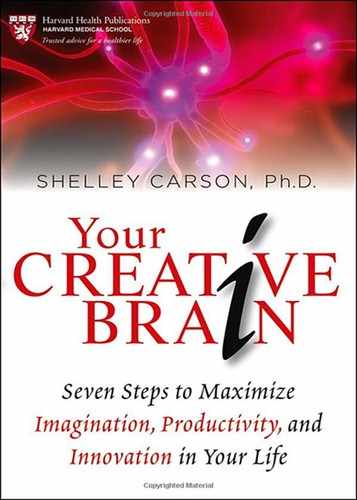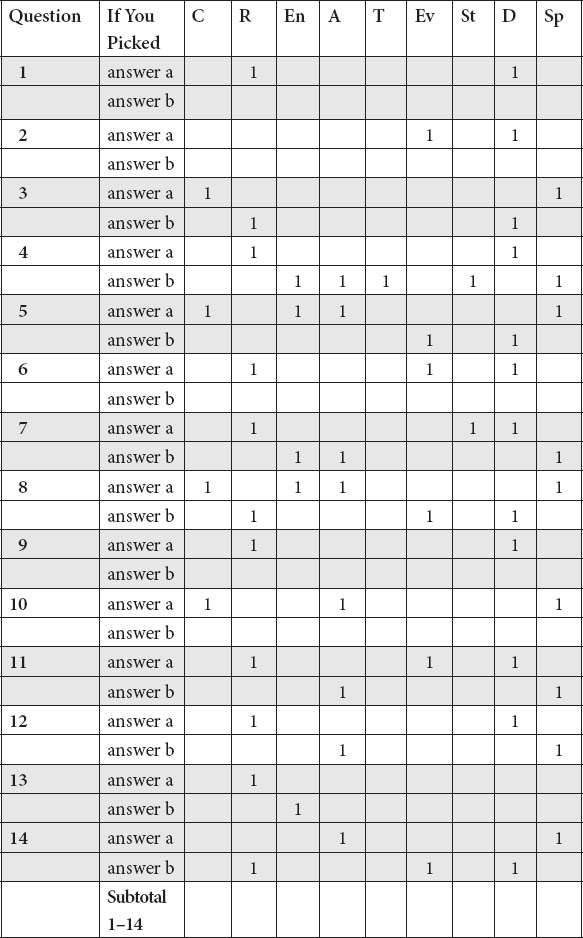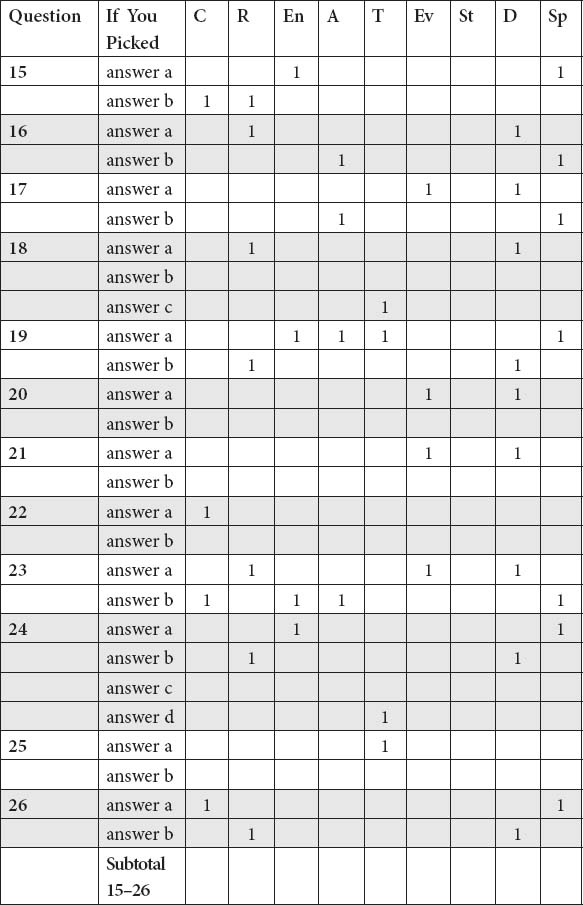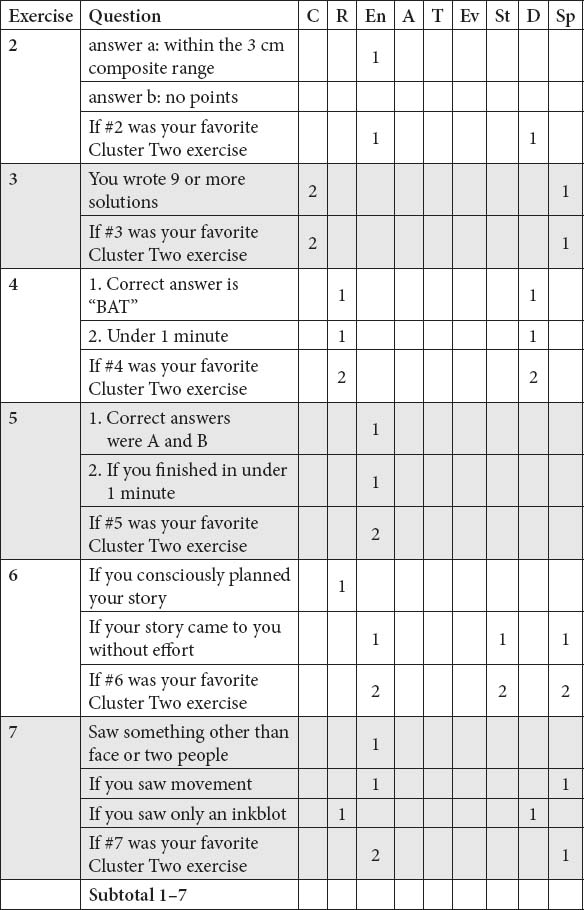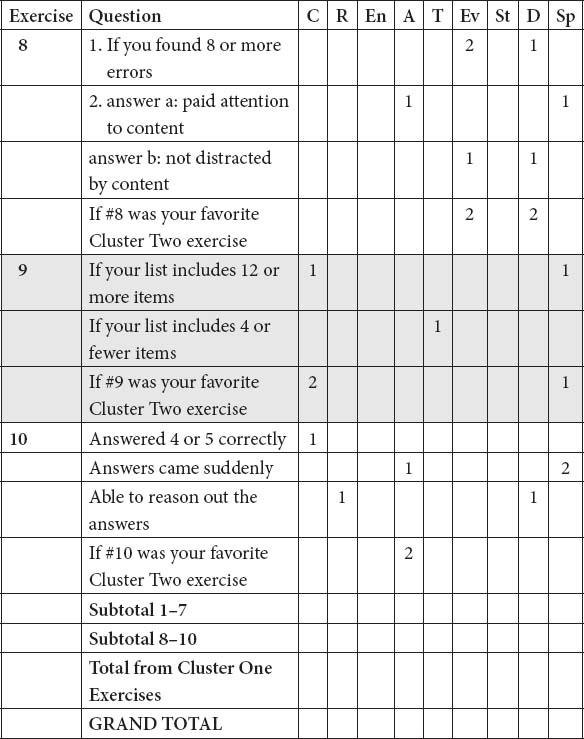 APPENDIX 1
APPENDIX 1
How to Score the CREATES Brainsets Assessment
THE ASSESSMENT TO DETERMINE WHICH OF THE CREATES BRAINSETS comprise your mental comfort zone contains two parts or clusters of responses.
Scoring Cluster One Questions
Circle your response for each question as well as the numbers in line with your response on the following grid (note that some answers may not have any numbers in line with them). Then total the number of circled responses in each column and add the totals for each page together at the end of the grid.
Your primary mental comfort zone is the column in which you have the highest number points in one of the first seven columns. Your secondary mental comfort zone is the column in which you have the next highest number of points. (Note that there are only two possible points available for the stream brainset. This brainset can be accessed during improvisation and performance, but is typically not a fall-back state or mental comfort zone.)
C = connect brainset
R = reason brainset
En = envision brainset
A = absorb brainset
Ev = evaluate brainset
St = stream brainset
Now look at your point count in the last two columns. This determines your preferred pathway to creative ideas. If you have the highest number of points in the D column, you prefer the deliberate pathway. If you scored higher in the Sp column, you prefer the spontaneous pathway. You'll learn about the deliberate and spontaneous pathways in Chapter Four. If your scores in the D and Sp columns were approximately the same, you are already able to flexibly switch between the two pathways. You will learn how to do this even more effectively in Chapter Twelve.
As you read through this book, pay particular attention to brainsets that do not match your favored mental comfort zone. Your goal is to develop the ability to access (and to tolerate) brainsets that feel uncomfortable to you now.
Scoring Cluster Two Exercises
Before you score the Cluster Two exercises, take a moment to think about which of the exercises you enjoyed the most and write down the number of that exercise. It will be important in the scoring because you will usually favor an exercise that reflects your mental comfort zone. You can use the grid that follows the explanation of the Cluster Two exercises to write your scores.
Exercise #1
This exercise tests your abilities to filter out irrelevant information and concentrate on a specific task. These skills are facilitated by entering into the reason brainset. You'll learn more about the reason brainset in Chapter Eight.
- The correct number of words that contain both s and t is 34. If you found 32, 33, or 34, give yourself 1 R and 1 Ev point (you can use the grid at the end of this Appendix to keep track of your Cluster Two points).
- Reading speed is partially dependent upon your ability to remain on task and keep your mind from wandering. If you were able to finish reading the passage in the allotted time, give yourself 1 R point.
- If you found that you were able to remain focused on the letters, give yourself 1 more R and 1 Ev point. If you found that you became distracted by or interested in the content of the reading passage, give yourself 2 A points. Becoming interested in stimuli around you to the point that you lose track of time and wander off task is a characteristic of the absorb brainset. You will be reading more about distraction and the absorb brainset in Chapter Five.
- If you remembered that the fusiform gyrus (answer c) was the part of the brain that recognizes faces, you were paying attention to the content of the passage rather than on finding the letters s and t. Give yourself 1 absorb point.
Finally, if Exercise #1 was your favorite of the Cluster Two exercises, give yourself 2 R points.
Exercise #2
This exercise is a measure of spatial ability. Specifically, it's a measure of your ability to localize an object in mental space and reproduce it at a later time. This type of mental visualization is a function of activation of the right hemisphere of the brain, which is most active in the envision brainset. You'll read more about visualization in Chapter Six.
If you were able to reproduce the dot in this exercise within the 3 cm as calculated by the instructions in Exercise #2 (part 2), give yourself 1 En point. This means you were able to visualize and hold in mind the location of the dot on the page.
If Exercise #2 was your favorite of the Cluster Two exercises, give yourself 1 En point.
Exercise #3
This exercise tests your ability to come up with multiple solutions to an open-ended problem. This is an ability most easily accessed through the connect brainset. You'll be learning more about open-ended problems in Chapter Seven. If you came up with nine or more answers about what to do with Ron, give yourself 2 C points.
If Exercise #3 was your favorite of the Cluster Two exercises, give yourself 2 C points.
Exercise #4
This exercise tests your ability to reason a problem out sequentially. This ability is most easily accessible through the reason brainset.
- The correct answer is BAT. If you got the correct answer, give yourself 1 R point.
- If you got the correct answer in under one minute, give yourself another R point.
If Exercise #4 was your favorite of the Cluster Two exercises, give yourself 2 R points.
Exercise #5
This exercise tests your ability to mentally manipulate 3-D objects. Mental rotation uses a different part of the brain than locating an object in mental space (as you did in Exercise #2). However, mental rotation is still a part of the mental imagery ability that is best accessed in the envision brainset.
- The correct answers are: A for the first rotation and B for the second rotation. If you got them both, right give yourself 1 En point.
- If you got both answers right in under one minute, give yourself an additional En point.
If Exercise #5 was your favorite of the Cluster Two exercises, give yourself 1 En point.
Exercise #6
This exercise challenges your imagination and ability to become absorbed in a task. Think about how you completed this task:
- If you stopped writing periodically and actively thought about what would happen next in your story give yourself 1 R point.
- If the story streamed into your head and you wrote without consciously planning what was going to happen next in your story, give yourself 1 St point and 1 En point.
If Exercise #6 was your favorite of the Cluster Two exercises, give yourself 2 En and 2 St points.
Exercise #7
This exercise is a “projective test” similar to the famous Rorschach inkblot tests used in psychiatric diagnosis (read more about inkblot tests in the Notes to Chapter Two).
The most common responses to this inkblot are to see it as a face or as two people facing each other.
- If you saw something other than a face or two people facing each other, give yourself 1 En point.
- If you saw people or objects moving in the inkblot, give yourself 1 En point.
- If you didn't see anything but a blot of ink, give yourself 1 R point.
If Exercise #7 was your favorite of the Cluster Two exercises, give yourself 2 En points.
Exercise #8
This exercise tests your ability to detect errors. This is best done in the evaluate brainset. You'll learn more about this aspect of creativity in Chapter Nine.
- If you were able to find eight errors on your first reading of this passage, award yourself 2 Ev points.
- If you found that you paid attention to the content of the passage and forgot to look for errors, award yourself 1 A point.
If you were able to spot the errors without being distracted by the content of the passage award yourself another Ev point.
If Exercise #8 was your favorite of the Cluster Two exercises, give yourself 2 Ev points.
Exercise #9
This exercise is similar to Exercise #3 in that it tests your ability to come up with multiple answers to a prompt. This is best done in the connect brainset. However, unlike #3, this exercise asks you to respond with answers of a personal nature.
- If you were able to come up with twelve or more small things that give you pleasure, give yourself 1 C point.
- If you came up with four or fewer small things that give you pleasure, give yourself one T point.
If Exercise #9 was your favorite of the Cluster Two exercises, give yourself 2 C points.
Exercise #10
This exercise tests your ability to access multiple associational networks and to solve problems using insight. You'll learn more about insight in Chapter Four. The problems in this exercise are called remote association problems; you can learn more about remote associations in the Notes to Chapter Two. In order to solve the problems, you need to keep associational networks related to all three word prompts open. This is best accomplished with the defocused attention of the absorb brainset. You'll learn more about defocused attention in Chapter Five.
Here are the answers to the problems:
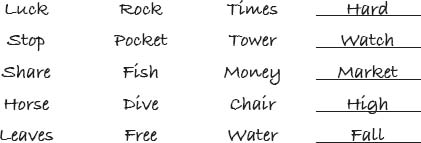
- If you were able to answer four or five of the problems within the time limit, give yourself 1 C point.
- If most of the answers came to you suddenly (the “aha!” effect), give yourself 1 A point.
- If you were able to answer four or five of the problems within the time limit but you consciously reasoned out most of the solutions, give yourself 1 R point.
If Exercise #10 was your favorite of the Cluster Two exercises, give yourself 2 A points.
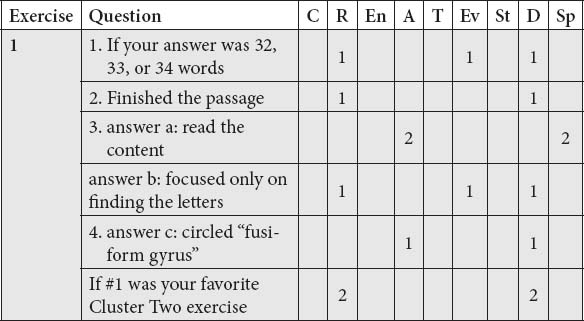
When you finish entering your points into the grid, add the total points from the Cluster One questions and then determine your total score for each brainset and for the deliberate and spontaneous pathways. Again, your primary mental comfort zone is the brainset in which you have the most points. Your secondary mental comfort zone is the brainset in which you have the next highest number of points.
